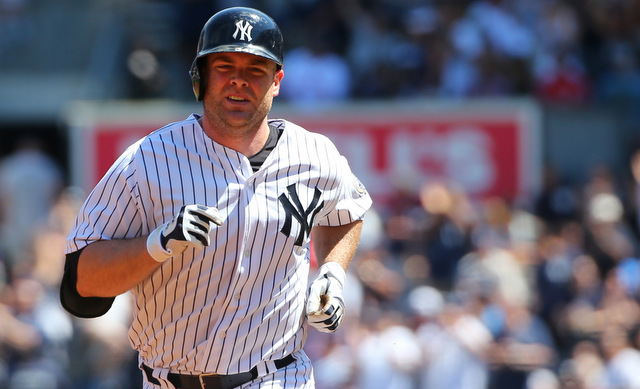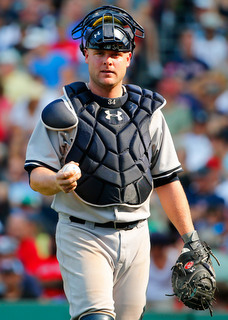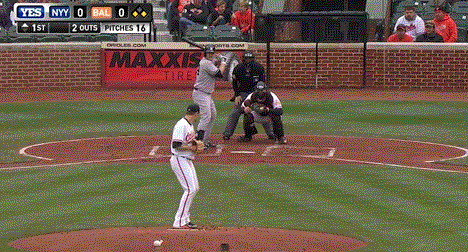
Two years ago the Yankees were desperate for catching help. That catching pipeline they put together in the minors didn’t amount to much — Jesus Montero was traded away, Austin Romine never developed, Gary Sanchez hit some speed bumps, etc. — so the team was forced into free agency. The Chris Stewart/Francisco Cervelli plan for 2013 failed miserably.
That venture into free agency brought veteran Brian McCann to the Bronx on a five-year contract worth $85M. Year one was a disappointment, at least offensively. The Yankees were expecting much more than a .232/.286/.406 (93 wRC+) batting line. Year two of the McCann era was better, but again, it was probably less than what the Yankees were expecting when they signed him, especially defensively.
More Comfortable in Year Two?
There was an awful lot of talk about McCann needing time to get comfortable in New York during and following his disappointing 2014 season. It was understandable too. He had a lot to process. New city, new teammates, new league, new division rivals, new coaches, new trainers, new pitching staff … that’s a lot to take in. It’s easy to understand why that may have impacted McCann’s performance.
“I think it’s typical with all of our guys. Unless you’re coming from the Red Sox, like (Jacoby) Ellsbury or Johnny Damon. They were used to that,” said Brian Cashman to Ken Davidoff about McCann’s adjustment period back in Spring Training. “I think our experiences have been, for players coming outside of the Northeast environment in New York, it doesn’t matter who you are. There’s definitely a settling-in period.”
McCann had kind of a normal Spring Training — he hit .234/.302/.404 with two homers in 19 games — for a veteran catcher. For him, the games were more about getting ready and getting familiar with the new pitchers on the staff, not so much about impressing coaches to a win roster spot. His job was safe. He was just going through the motions. At least this year he had an idea of what to expect in camp.
“I know the league a lot better,” said McCann over the summer. “I’ve seen all these guys for a fourth and fifth and sixth time. When you’re changing leagues, that’s kind of what you take for granted is facing the No. 1’s and 2’s, the lefty specialists all for the first time. I’m definitely more comfortable in that aspect.”
First Half Dominance
During the first half of the 2015 season, McCann put up a stellar .259/.331/.471 (117 wRC+) batting line with 14 home runs in 72 games. That was right in line with the .256/.336/.461 (122 wRC+) batting line McCann put up in his final season with the Braves. He was back to where he was prior to that disappointing 2014 season. It was great to see.
Amazingly, McCann actually started the season poorly, so poorly that he bottomed out at .228/.279/.382 (76 wRC+) with four home runs on May 19th, 136 plate appearances into his season. It not only looked like McCann wasn’t going to rebound in year two with the Yankees, but it looked like he was declining even further six weeks into the new season. It was pretty scary!
McCann’s bat took off soon thereafter — he hit a home run in four consecutive games from May 25th to 29th — and he was an absolute monster at the plate the rest of the first half. From May 20th through the All-Star break, a span of 39 games and 154 plate appearances, McCann hit .288/.377/.553 (153 wRC+) with ten homers. His biggest homer came on July 3rd:
Second Half Swoon
Like most Yankees, McCann slumped big time in the second half. He did swat 12 home runs in 63 games after the break, but that came with a .200/.306/.395 (91 wRC+) batting line. Granted, a 91 wRC+ isn’t bad by catcher standards — the league average catcher had an 85 wRC+ in 2015 — but the Yankees were counting on McCann to be a middle of the order thumper, and he wasn’t doing that in the second half.
Looking at McCann’s batted ball profile, it’s easy to see what happened in the second half:
 The blue line represents McCann’s fly ball rate while the green is grounders and the red is line drives. McCann put the ball in the air way more often in the second half, and it’s not just that he hit more balls in the air, he hit more weak pop-ups. You know what I mean, those uppercut swings that result in McCann immediately putting his head down after contact. These fly balls:
The blue line represents McCann’s fly ball rate while the green is grounders and the red is line drives. McCann put the ball in the air way more often in the second half, and it’s not just that he hit more balls in the air, he hit more weak pop-ups. You know what I mean, those uppercut swings that result in McCann immediately putting his head down after contact. These fly balls:
We see an awful lot of those weak pop-ups when McCann is struggling that the plate. Fly balls like that are BABIP killers. They’re easy outs even the worst defensive outfielders can convert. McCann went from a .271 BABIP in the first half to a .191 BABIP in the second half.
The poor BABIP in the second half was not dumb luck. This is not a “just give him some more at-bats and it’ll even out” situation. McCann’s swing and approach in the second half resulted in a lot of those towering pop-ups that are easy for the defense to catch. He had a low BABIP because the balls he was putting in play were easy to turn into outs. It’s the same thing that plagued McCann in 2014.
McCann finished the regular season in a 3-for-28 (.107) slump and went 0-for-4 with three ground outs and a fly out in the wildcard game. He swung at the first pitch and grounded out to shortstop in the ninth inning to end the season.
Between the great first half — given that slow start, wasn’t it really more like 39 great games? — and the dreadful second half, McCann hit .232/.320/.437 (105 wRC+) with a career high 26 home runs this past season. The home runs are great! The Yankees signed McCann to hit dingers and take advantage of the short porch, and, sure enough, he hit 20 of those 26 home runs at Yankee Stadium.
McCann’s walk rate rebounded from a career low 5.9% last year to 9.7% this year, which is right in line with his career average (9.2%). His strikeout rate was actually a career high (18.1%) yet still below the league average (20.4%). McCann struck out 14.3% of the time last season. His power production increased a bit and his walk rate returned to normal in 2015, but McCann also had a .235 BABIP, which is the new normal. He has .241 BABIP in his last 2,000 plate appearances dating back to 2012.
At this point of his career, there’s little reason to think McCann will ever hit for a decent batting average again. Maybe he has a lucky year and some of those pop-ups start falling in, but that seems unlikely. Chances are McCann is a low average, decent on-base, high power hitter from here on out. That’s useful, especially at the catcher position, but it’s not star caliber production. It’s just solid. McCann is now two years into his contract and that’s really all you can say. He’s been solid. Nothing more.
Declining Glove
The Yankees value catcher defense very highly and that’s a huge reason why they targeted McCann. Not only was he one of the best offensive catchers in the league, he was also an elite gloveman. We saw it last season, when he threw out 37% of base-runners, rated as a top notch pitch-framer, and excelled at blocking balls in the dirt. He was the total package behind the plate.
This past season, McCann was something less than that. He still threw out a ton of attempted base-stealers — McCann threw out 28 of 78 this year, or 36% (league average was 32%) — but the various stats say he took a step back as a pitch-framer. Both Baseball Prospectus and StatCorner rated McCann as right around league average in 2015. Last year both had him near the top.
Pitch-framing is rather fickle and I still have questions about the exact run values, but it is obviously a valuable skill you’d like your catcher to possess. The eye test is … tough. It’s tough to evaluate pitch-framing with your eyes because you don’t know if the catcher deserves props or if the umpire was going to call it a strike anyway. The stats say McCann’s framing took a step back this year. How much of a step back? That’s debatable. But a step back.

Blocking balls in the dirt is another matter. Those are pretty easy to evaluate with your eyes and gosh, McCann was pretty terrible at it this year. McCann was behind the plate for 56 passed pitches this year, fourth most in baseball. Here’s the funny thing: he was charged with one passed ball. The other 55 passed pitchers were wild pitches. That … yeesh. That seems hard to believe based on what I saw this year.
The Yankees do have a tough-to-catch pitching staff. Masahiro Tanaka, Chasen Shreve, and Nathan Eovaldi were bouncing splitters all summer and both Justin Wilson and Dellin Betances had no idea where the ball was going at different points of the season. But geez, just one passed ball? Really? That seems wrong. I remember seeing more than a few blockable pitches scoot away from McCann this summer.
Last season McCann allowed one passed pitch every 22.8 innings. This season it was one every 18.6 innings. That matches up with the anecdotal evidence — McCann allowed balls to get by him at a higher rate this summer. It’s not surprising either. He’s a 31-year-old catcher who has been a big league starter since age 21. That’s a lot of wear and tear on his legs. Of course McCann is not as mobile as he once was.
I’m going to go back to this word again, but McCann’s total package on defense was solid this year. He was great at throwing out base-runners but his framing and blocking took a step back. Between the offense and defense, McCann was an above-average catcher this summer, rather easily too, but the signs of decline are evident both offensively (bye bye BABIP) and defensively.
Looking Ahead to 2016
McCann has another three years and $51M coming to him, so of course he’s going to be the starting catcher next season. He should be too. I’m the world’s biggest John Ryan Murphy fan but McCann is the better player right now and should start. There’s almost no way to argue otherwise.
Joe Girardi indicated at his end-of-season press conference that he may begin to scale back on McCann’s workload going forward — he started 119 games behind the plate this year, his most since 2010 — which is smart at this point of his career. Fewer days behind the plate and a few more at DH could help keep him productive deeper into the season. Either way, McCann will be back behind the plate and in the middle of the lineup next year.

Leave a Reply
You must be logged in to post a comment.